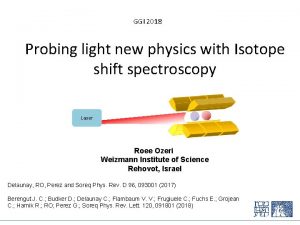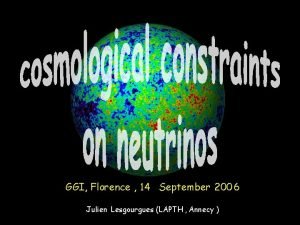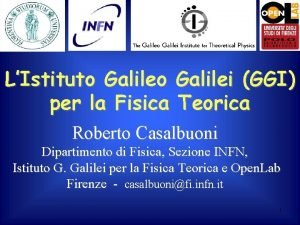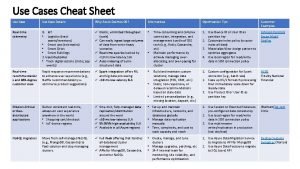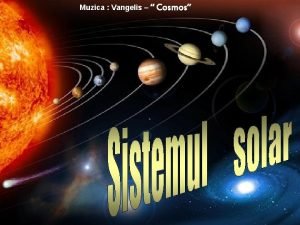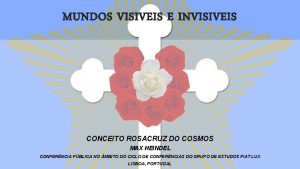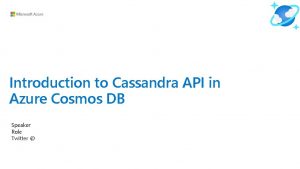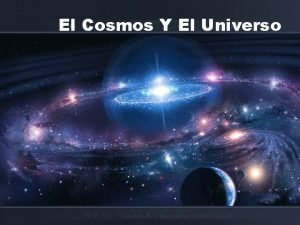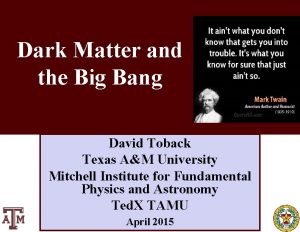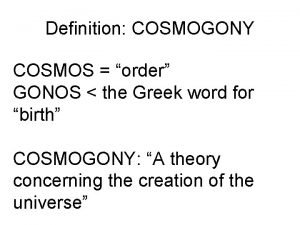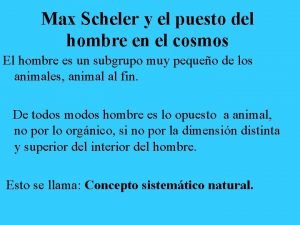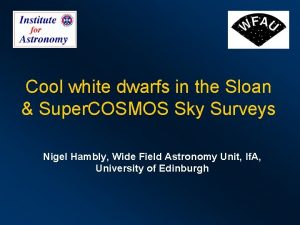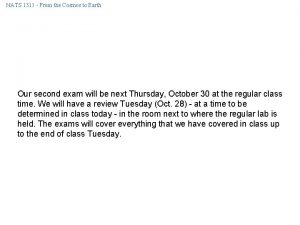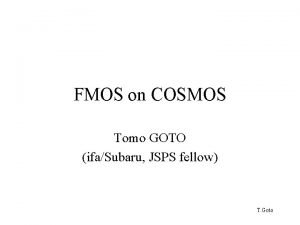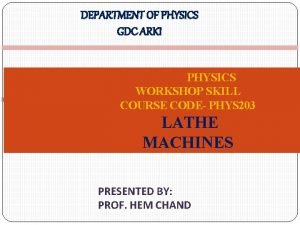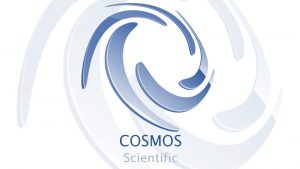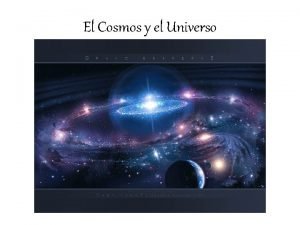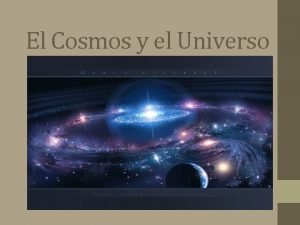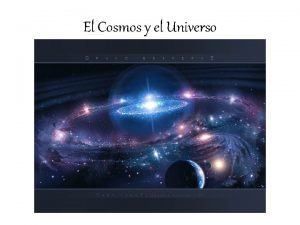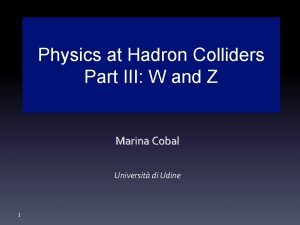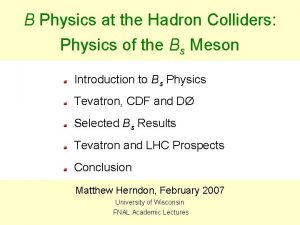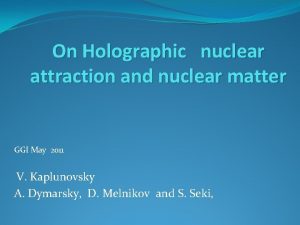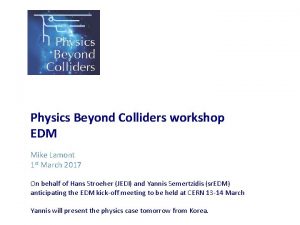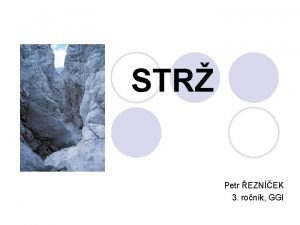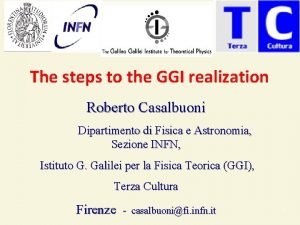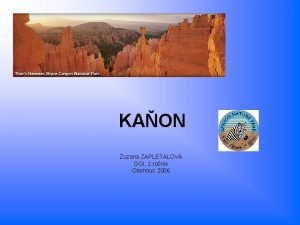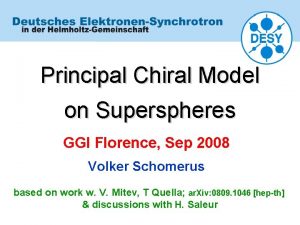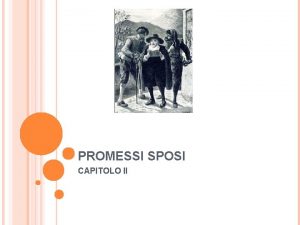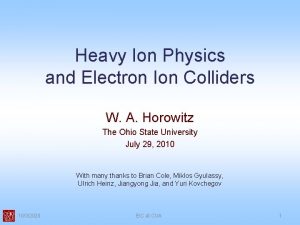GGI workshop Colliders Physics and the Cosmos 25

































- Slides: 33

GGI workshop: ”Colliders Physics and the Cosmos” (25 th -29 th September 2017) Collider Physics, High Energy Cosmic Rays and Neutrinos (25 th -29 th September 2017) A summary of the main points Frank Deppisch, Ralph Engel, Paolo Lipari, James Pinfold

The Talks 1. Neutrinos, 0 nbb and the LHC – Frank Deppisch 2. Searching for Monopoles and Other Exotica at Colliders and in Cosmic Rays – James Pinfold 3. From the Knee to the Ankle – What Astroparticle physics and Collider physics together can say about the main features of the cosmic ray energy spectrum – Paolo Lipari 4. Ultra-High-Energy Cosmic Rays and Hadronic Interactions Part 1: Cosmic-Ray Physics – Ralph Engel 5. Ultra-High-Energy Cosmic Rays and Hadronic Interactions Part 2: Particle Physics Aspects – Ralph Engel

Neutrinos, 0 nbb and the LHC • Neutrinos much lighter than other fermions – Dirac or Majorana? Lepton Number Violation? – ◦Neutrino masses need BSM physics, but at what scale? • Neutrino physics is BSM physics – Neutrino mass models can be searched for at LHC – Wide range of scenarios and signatures • Observation of LNV processes – Likely pinpoints the origin of neutrino mass generation – Can falsify high scale baryogenesis scenarios • Important information for model selection, e. g. – Observation of 0 nbb – Observation of LNV at the LHC




Searching for Monopoles and Other Exotica at Colliders and in Cosmic Rays • Mo. EDAL is the newest experiment at the LHC that started data taking at √s=13 Tev in 2015 – Aim to search for highly ionizing avatars of new physics, very longlived particles and highly penetrating phenomena – Complementary to general purpose LHC detectors ATLAS & CMS – The search for the magnetic monopole uo to 6 -7 Te. V mass is a key aim, but many others defined (Int. J. Mod. Phys. A 29 (2014) 1430050) – Possible use of MAPP (Mo. EDAL Apparatus for Long-Lived particles) subdetector propoed at this meeting, for • Searching for heavy sterile neutrinos (RE: Frank’s talk) • High energy muons studies useful in understanding cosmic muons may be possible – the possibility arose from the meeting (RE: Ralph’s 2 nd talk on the muon problem)



Mo. EDAL Apparatus for Penetrating Particles (MAPP) MAPP will be able to take data in p-p, p-A, A-A and also fixed target interactions using SMOG (an internal gas target in LHCb) MAPP has three motivations To search for particles with charges <<1 e (ATLAS & CMS limited to searches with particles of charge e ≥ 1/3) To search for new pseudo-stable neutrals with long lifetime and anomalously penetrating particles 10

Cosmic-Mo. EDAL • With a high altitude, large area array using same Nuclear Track Detector Technology used in Mo. EDAL we can extend the search for monopoles from the LHC’s Te. V scale to the GUT scale. • Such a array can also search for other exotic cosmic particles: Q-balls, nuclearites, primordial black holes, microscopic black hole remnants and other highly ionizing particles produced in UHECR air showers • A good example of the synergy between collider and cosmic ray physics that is the topic of this meeting • The initial planning is now underway


From the Knee to the Ankle…. . • Overview of the landscape of cosmic ray air shower physics and its synergy with particle physics • Uncertainties in the air shower models – Need to include diffraction, elastic scattering, etc. • “An understanding of the origin of the positron and antiproton fluxes is of central importance for High Energy Astrophysics” • The e-, e+, p-bar spectra found from AMS, PAMELA, etc. – What can we learn from the ration of e+/p-bar – why are they similar (e+/p -bar ~ 2 at E > 30 Ge. V)? – Is there a secondary origin for both fluxes – Is he energy dependence of the e-/p fluxes NOT the effect of propagation, but formed at injection? – Is there a new source of positrons to compensate for energy loss of positrons? – Will the spectrum turn down? Etc.


Ultra-High-Energy Cosmic Rays and Hadronic Interactions Part 1: Cosmic-Ray Physics • AUGER and TA description and differences • What is the origin of the flux suppression at 6 x 1019 e. V? • Composition estimate using rise time of signal and shower fluctuations • Composition dependence changing with energy • Change of model predictions thanks to LHC data • Proton-air cross-sections • Large Scale anisotropy • Transition from galactic to extragalactic CRs • Photon and neutrino fluxes at very high energies • TA x 4 Project and Auger. Prime status and physics reach








Ultra-High-Energy Cosmic Rays and Hadronic Interactions Part 2: (1) • Composition interpretation essential for understanding astrophys • LHC data of central importance for more reliable composition interpretation – Good collaboration between members of CR community & LHC/HEP – Feedback from air-shower observations, CR int. models successful at LHC • Cosmic ray data at 1019. 5 e. V likely not protons (except exotic physics) • p interactions as major uncertainty for muon discrepancy id’ed – Need measurement of energy dependence of ρ0 production – Consistent description at lower energy, transition to direct measurements • Forward charm production of increasing interest • Primary flux composition also directly linked to inclusive lepton fluxes

Ultra-High-Energy Cosmic Rays and Hadronic Interactions Part 2: (2) • So far models only tuned for p-p interactions (& partially p-Pb, Pb -Pb) – – – Models with similar p-p predictions differ significantly for p-O EG: difference in multiplicity prediction of models corresponds to difference between p and He of cosmic ray particles (ΔXma ~20 g/cm 2) Forward particle production in p-O essentially unknown Peripheral collisions in p-O much more important than in p-Pb Model predictions give only lower limit to real uncertainty due to similar assumptions, – need data to estimate real uncertainty









 Ggi new physics from the sky
Ggi new physics from the sky Florence julien model
Florence julien model Ggi florence
Ggi florence Cosmos cheat
Cosmos cheat Cosmos vangelis
Cosmos vangelis Conceito rosacruz do cosmos
Conceito rosacruz do cosmos Cassandra api cosmos db
Cassandra api cosmos db El cosmos y el universo
El cosmos y el universo Azure cosmos db query cheat sheet
Azure cosmos db query cheat sheet Dave toback cosmos
Dave toback cosmos Pyc2601
Pyc2601 Definition of cosmogony
Definition of cosmogony Cosmos db session token
Cosmos db session token Undergraduate meaninh
Undergraduate meaninh Cosmos db query optimization
Cosmos db query optimization Concepción del hombre
Concepción del hombre Super cosmos
Super cosmos Db
Db Cosmos air
Cosmos air Azure cosmos db: sql api deep dive online courses
Azure cosmos db: sql api deep dive online courses Cosmos db ru calculator
Cosmos db ru calculator Imagenes de cosmos y el universo
Imagenes de cosmos y el universo Core sql api
Core sql api Cosmos ssp
Cosmos ssp 3 jaw chuck grasp examples
3 jaw chuck grasp examples Why does it happen
Why does it happen University physics with modern physics fifteenth edition
University physics with modern physics fifteenth edition Ib physics
Ib physics Hát kết hợp bộ gõ cơ thể
Hát kết hợp bộ gõ cơ thể Lp html
Lp html Bổ thể
Bổ thể Tỉ lệ cơ thể trẻ em
Tỉ lệ cơ thể trẻ em Gấu đi như thế nào
Gấu đi như thế nào Chụp phim tư thế worms-breton
Chụp phim tư thế worms-breton
